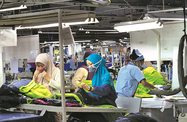Mongolia: Volatility in cashmere
Unexpected fluctuations in cashmere prices in 2012 have dampened optimism in Mongolia’s textiles sector, despite the introduction of incentives from the government aimed at streamlining the industry. However, industry players say a planned commodities exchange will resolve the issue.
After opening at MNT70,000 ($52) per kg in the March-April buying season for the country’s pivotal cashmere industry, prices quickly fell to as low as MNT40,000 ($30) per kg. Local media reported that herders had expected to see prices climb as high as MNT100,000 ($75) per kg.
Producers and herders blame the dip on traders from China, accusing them of straying from National Cashmere and Wool Association (NCWA) price estimates, which were between MNT56,000 and MNT58,000 ($42-43). However, officials say the instability was a result of government loans being misused by domestic producers who “conspired” to drive prices up.
Reports by international groups suggest local traders indeed attempted to influence the market. The World Bank wrote in its Quarterly Economic Update, published in June, that “herders and traders attempted to push up prices of greasy (raw) cashmere by limiting the volume of greasy being sold on the market and available for export”. As a result, export earnings from greasy cashmere were down by 57% year-on-year (y-o-y) in the first quarter of 2012, while export volumes were 36% lower.
In September 2011, the Ministry of Finance issued MNT300bn ($223.55m) worth of Mongolian bonds to raise funds to support the wool and cashmere sector. The world’s second-largest producer following China, Mongolia produces around 6700 tonnes of raw cashmere annually, accounting for about 28% of total world supply.
“Herders and traders tried to set the price of greasy at record-high levels by holding on to their stock. Chinese buyers are dominating, while local de-hairers and spinners are still very quiet,” wrote the Schneider Group, a global wool-processing firm, in an update in April.
According to T. Sedvanchig, a member of parliament, the failure of local producers to buy domestic raw cashmere at reasonable prices was irresponsible, given this year’s fund injection. Sedvanchig also told local media in April that it is unfair to blame Chinese traders. “Even when the Chinese traders are not buying cashmere or its raw materials, the Mongolians should still be buying cashmere at a constant price and rate. We did not issue these loans so local firms can conspire with each other and put the lives of our herders at risk,” he added.
Of the MNT300bn ($223.55m) raised by the government, MNT150bn ($111.77m) was slated for the development of small and medium-sized enterprises, MNT50bn ($37.26m) was allocated to herders who sell camel and sheep wool to domestic factories and MNT100bn ($74.52m) was meant to support the producers.
“The price fluctuation was not to be more than MNT5000 ($4),” Sedvanchig said. “The loan granted to producers was supposed to be used to make their textile factories operate at full potential, to provide more jobs, and to buy raw materials, including materials that are currently going directly to foreign countries without being processed for added value. It is a government competition strategy to make sure that Mongolian companies and traders buy the raw materials before the Chinese do.”
Current annual revenues of around $180m are dominated by sales of raw cashmere, mostly to China, which make up 80% of total exports. However, if the country had the capacity to refine all of its cashmere before export, it is estimated profits could rise to between $480m and $520m. The industry-wide goal for 2012 was to turn at least 30% of raw cashmere into yarn domestically.
Despite the controversy over the funds, the introduction of a unique trademark for Mongolian cashmere products by the Ministry of Food, Agriculture and Light Industry (MFALI) in April is a sign of progress toward improving the industry’s profitability. B Batsetseg, the head specialist at the Light Industry Strategy Implementation Department of the MFALI, told local media that the brand, “Mongolian Tansag Shirhegt” (Mongolian Luxurious Texture), will be used for goat cashmere, camel and yak furs.
Industry players have told local media that the implementation of the Agricultural Market Law, which established the Mongolian Agricultural Commodity Exchange (MACE) for trading agricultural goods and raw material, could resolve price issues within the industry. The MACE, established in July, has been designed to cover all products of animal origin and raw materials, as well as act as a mechanism to ensure fair prices.
It is expected that MACE, based in Ulaanbaatar, will communicate with rural regions at auction sales and with raw material cooperatives in provinces to communicate prices by internet or telephone. Some 34% of Mongolia’s 1.1m labour force works in agriculture, primarily tending livestock, which includes the goats that yield cashmere fibres.
“It was difficult to complete the preparation work needed quickly enough [to use the exchange this year]. Direct enforcement would have not been easy. It was impossible to implement it this year,” said G. Yondonsambuu, the vice leader of the NCWA. “But next year, we will start selling on the bourse.”
However, unless the government can improve communication between its ministries and cashmere business associations, as well as improve coordination in the industry, even the new commodities exchange will struggle to end the instability affecting this pivotal segment of the economy and vital source of income for rural Mongolians.


